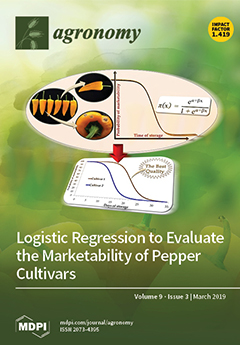Photosynthesis is the basis for plant productivity, and improvement of photosynthetic efficiency is an important way to improve crop yield. However, the relationship between photosynthetic parameters and the yield of Tartary buckwheat (
Fagopyrum tataricum) under rainfed conditions is unclear. A two-year
[...] Read more.
Photosynthesis is the basis for plant productivity, and improvement of photosynthetic efficiency is an important way to improve crop yield. However, the relationship between photosynthetic parameters and the yield of Tartary buckwheat (
Fagopyrum tataricum) under rainfed conditions is unclear. A two-year field trial was conducted during 2016 and 2017 to assess the photosynthetic capacity of different leaves, dry matter accumulation, and yield of four Tartary buckwheat cultivars from flowering to maturity. The leaves of all cultivars aged gradually after flowering, and the leaf chlorophyll (Chl) and soluble protein (SP) contents, net photosynthetic rates (P
n), transpiration rates (T
r), and stomatal conductance (G
s) tended to decline. The Chl, SP, P
n, T
r, and G
s of cultivars (cvs.) XiQiao2 and QianKu3 were significantly higher than those of LiuKu3 and JiuJiang at each sampling time from 18 days after anthesis to maturity, but the intercellular CO
2 content (C
i) showed the opposite trend. Cultivars XiQiao2 and QianKu3 produced more total dry matter (mean 17.1% higher), had higher harvest index (HI, mean 16.4% higher), and yield (mean 29.0% higher) than cvs. LiuKu3 and JiuJiang at maturity, and the difference was remarkably consistent. The yield of all the cultivars was positively correlated with leaf Chl, SP, P
n, T
r, and G
s, but negatively correlated with C
i. At late growth stages, the high-yielding cultivars maintained higher Chl, SP contents, P
n, T
r, and G
s, and showed higher dry matter accumulation and lower C
i than the low-yielding cultivars, consistent with their higher leaf photosynthetic capacity. The important factors determining the yield of Tartary buckwheat were maintaining higher leaf Chl and SP content and photosynthetic capacity and delaying aging during the grain formation stage. Enhanced rates of photosynthesis and dry matter accumulation led to higher post-anthesis accumulation of biomass with a positive impact on grain number and higher yield.
Full article





